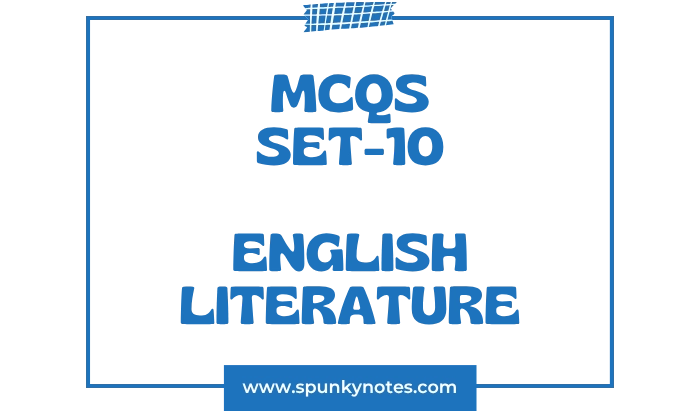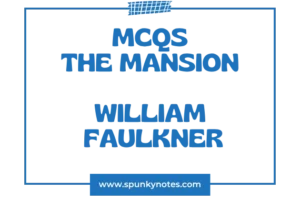

Estimated Reading Time: 23 min
English Literature MCQs
Set-10
1. In T. S. Eliot’s theory of impersonality, the poet is compared to which of the following?
A. A sculptor
B. A catalyst
C. A historian
D. A prophet
2. “Objective correlative” as a device to express emotions through a set of objects or situations was popularized by:
A. John Crowe Ransom
B. T. S. Eliot
C. F. R. Leavis
D. Cleanth Brooks
3. The term “Negative Capability” was coined by which Romantic poet?
A. Percy Bysshe Shelley
B. William Wordsworth
C. John Keats
D. Lord Byron
4. Who wrote the essay “The Function of Criticism at the Present Time”?
A. Samuel Taylor Coleridge
B. Matthew Arnold
C. John Dryden
D. F. R. Leavis
5. The phrase “A willing suspension of disbelief” is associated with which critic-poet?
A. William Blake
B. S. T. Coleridge
C. W. B. Yeats
D. T. S. Eliot
6. Astrophel and Stella by Sir Philip Sydney reveals :
A. The rich love between the two
B. The unhappy love between the two
C. The nature of ideal love
D. The hurdles in love
7. “He was as fresh as is the month / Of May and as the new abaysshed nightingale.” These lines are from:
A. The Book of Duchess
B. Confessio Amantis
C. Prologue to Canterbury
D. Troilus and Crisevde
8. In Shakespeare’s Antony, Cleopatra, Antony is recalled to Rome due to:
A. Octavius’ jealousy
B. the death of his wife Fulvia
C. the estrangement with Cleopatra
D. his marriage with Octavia wife Octavia
10. Women Beware Women by Thomas Middleton is :
A. a religious satire
B. a political satire
C. a tragedy
D. a utopian work
11. The Satan of Paradise Regained describes himself as :
A. a fallen Angel
B. an unconquerable spirit
C. a spirit unfortunate
D. an enviable spirit
12. Who represents allegorical public figure of the Duke of Monmouth in Absalom and Achitophel
A. Absalom
B. Achitophe
C. David
D. Corah
14. In which book of Gulliver’s Travels, Swift satirises the Royal Society ?
A. Book-I (Lilliput)
B. Book-II (Brobdingnag)
C. Book-III (Laputa, Balnibarbi, Luggnagg, Glubbdubdrib)
D. Book-IV (Houyhnhnms and Yahoos)
15. Joseph Andrews is greatly influenced by the following work :
A. Don Quixote
B. Clarissa
C. Robinson Crusoe
D. Pilgrim’s Progress
16. ‘Role playing’ is a major motif in:
A. The Good Natured Man
B. Sentimental Comedy
C. Cato
D. She Stoops to Conquer
17. “But most thro’ midnight streets I hear / How the youthful Harlot’s curse / Blasts the new born Infant’s tear / And blights with plagues the Marriage hearse” Identify the poem in these lines
A. Infant Sorrow
B. London
C. Angerie of Innocence
D. The New Jerusalem
18. Identify the poem which has an element of humour in it:
A. The Prelude
B. Lamia
C. Hours of Idleness
D. Peter Bell, the Third
19. Name the novel of Jane Austen in which a young Parson is a desirable suitor and prospective husband for a sensible young girl.
A. Pride and Prejudice
B. Emma
C. Mansfield Park
D. Northanger Abbey
20. ‘She Walks in Beauty’ is a poem written by:
A. John Keats
B. R.W. Emerson
C. Lord Byron
D. P.B. Shelley
21. “On Murder considered as one of the Fine Arts” is written by
A. Robert Morrison
B. Thomas De Quincey
C. Alexander Morris
D. Alexander Dumas
23. Charles Dickens’, A Tale of Two Cities was inspired by:
A. On Liberty by John Stuart Mill
B. The French Revolution by Carlyle
C. Essays Critical and Historical by T.B. Macaulay
D. Reflections on the Revolution in France by Edmund Burke’s
24. Identify the autobiographical novel of George Eliot.
A. Middlemarch
B. The Mill on the Floss
C. Daniel Deronda
D. Adam Bede
25. Identify the poem in which the following lines occur :
“The old order changeth, yielding place to new,
And God fulfils Himself in many ways.”
A. In Memoriam
B. Ulysses
C. Morte d’ Arthur
D. The Lady of Shallot
26. Name the author of the work Modern Painters.
A. John Ruskin
B. William Morris
C. Walter Pater
D. Christina Rossetti
27. The following play was inspired by Ibsen’s “The Doll’s House”.
A. Lady Windermes
B. The Second Mrs. Tanqueray
C. Candida
D. The Land of Heart’s Desire
29. Lady Wishfort does not want her niece to marry Mirabell because :
A. She wants Millamant’s fortune
B. She is angry with Mirabell because he pretended to love her
C. She wants her daughter Mrs. Fainall to marry Mirabell
D. She wants Tony Witwould to marry Mirabell
30. “But at my back I always hear / Times winged chariot hurrying near.” Who has written these these lines ?
A. Andrew Marvell
B. John Donne
C. George Herbert
D. Pichard
31. Who was the co-author of the play “The Personal Enemy” along with Johr Osborne ?
A. Antony Creighton
B. Harold Pinter
C. Eugene Ionesco
D. Samuel Beckett
32. “Long-legged Fly” was a poem
A. Edward Thomas
B. W.B. Yeats
C. Robert Bridges
D. John Masefie
33. Madam Sosotr [is a] character in the following poem:
A. The [Love Song] of J. Alfred [Prufrock]
B. Geronton
C. The Wasteland
D. Ash-Wednesday
34. Name the author of the lines : “Lay [your] head, my love, / Human on my faithless arm.”
A. Stephen Spender
B. Louis MacNeice
C. W.H. Auden
D. C. Day Lewis
35. Alison in Look Back in Anger can be considered as:
A. Social Snob
B. Dutiful daughter
C. Suffering wife
D. Angry rebel
36. Identify the false statement about Waiting for Godot from the following:
A. The play has asymmetrical symmetry
B. The boy who comes in Act 2 is different from the boy who comes in Act 1
C. Lucky’s speech is a parody of academic discourse
D. The play ends with a recognition
37. Identify the novel that uses the narrative style of the 19th century realistic novel.
A. The French Lieutenant’s Woman
B. The Collector
C. The Magus
D. Mantissa
38. The following poet is known for his anthropomorphism:
A. Philip Larkin
B. Ted Hughes
C. Donald Davie
D. D.J. Enright
39. Identify a campus novel from the following:
A. Heart of the Matter
B. Brighton Rock
C. Lucky Jim
D. Clockwork Orange
40. Identify the false statement from the following as per Aristotle’s Poetics:
A. A tragedy should not deal with the fall of a good man from prosperity to adversity
B. A tragedy should not show the fall of a bad man from prosperity to adversity
C. A tragedy should not show the rise of a bad man from adversity to prosperity
D. Tragedy as a literary genre is inferior to epic
42. Coleridge’s idea on Imaginati[o]n [is] a rejection of:
A. British empiricism
B. Transcendentalism
C. British imperialism
D. Radicalism
43. The Timber was authored by
A. Ben Jonson
B. Philip Sidney
C. Steven Gosson
D. George Puttenham
44. [Which] one of the following does not apply to New Critical Method?
A. It looks for irony and paradox
B. It uses the biography of the author
C. It disregards the context of the text
D. It sees the text as autonomous
45. Who is the French feminist whose account of cultural construction of woman as “Other” became very popular?
A. Julia Mitchell
B. Julia Kristeva
C. Simone de Beauvoir
D. Robin Morgan
46. Name the organization founded by Betty Friedan, the writer of The Feminine Mystique.
A. National Organization for Women
B. Equal Opportunity Commission
C. Backlash
D. Third Wave Organization
47. Who wrote History and Class Consciousness?
A. Terry Eagleton
B. George Lukacs
C. Leon Trotsky
D. Lucien Goldman
49. Deconstruction as a critical practice emphasizes :
A. Rejection of essentialism
B. Glorification of grand narrative
C. The centrality of the signified
D. The primacy of the text
50. Match the following Works with their Writers and choose the [correct option] from the codes given below it: (1) Sexual Politics, (2) The Dialectic of Sex, (3) Sisterhood is Powerful, (4) The Female Eunuck with (I) Kate Millett, (II) S. Firestone, (III) Robin Morgan, (IV) Germaine Greer
A. (3) (2) (1) (4)
B. (2) (3) (4) (1)
C. (3) (4) (1)
D. (1)
52. [English] as a language is often referred to by the name of the tribés that settled in England around 449. Identify its name:
A. Romance language
B. Anglo-Saxon language
C. language
D. Latinate language
53. Audio-lingual method is associated with:
A. Promoting class-room interaction
B. Promoting task-based learning
C. Promoting class-room repetition
D. Promoting collaborative learning
54. Communicative language teaching focuses on four competencies. ‘Grammatical’, ‘Sociolinguistic’ ‘Strategic’ and
A. Performative
B. Negotiative
C. Discourse
D. Evaluative
55. The term ‘Lexicography’ is used for:
A. Word analysis
B. Lexical geography
C. Dictionary making
D. Word formation
57. Dante en[counters] Beatrice in :
A. Inferno
B. Purgatorio
C. Paradiso
D. All of these
58. Goethe’s Faust embodies the spirit of:
A. Romanticism
B. Renaissance
C. Classicism
D. All the three
59. Anton Chekhov’s The Cherry Orchard is a:
A. Tragedy
B. Comedy
C. Tragi-Comedy
D. Sentimental Comedy
60. Which of the following is not a remarkable characteristic of Ibsen’s plays from 1875 to the 1890s?
A. Tragedy of ordinary people in dialogue rose
B. Unique quality of b[ringing out] the central character
C. Discarding of conventional theatrical effects
D. Existential crises
61. Which of the following plays introduced the concept of the “Theatre of the Absurd”?
A. Death of a Salesman
B. Waiting for Godot
C. Pygmalion
D. Arms and the Man
62. The Concept of the Third Theatre was propounded by:
A. Vijay Tendulkar
B. Mahesh Dattani
C. Girish Karnad
D. Badal Sircar
63. Nayantara Sahgal’s memoir on Indian Independence is known as
A. Meatless Days
B. Prison and Chocolate Cake
C. A Wounded Civilization
D. Sunlight on a Broken Column
64. Whose lines are these? “Into that heaven of freedom, my father, / Let my country awake!”
A. Rabindranath Tagor[e]
B. Sarojini Naidu
C. Sri Aurobindo
D. Mahadevi Verma
65. Which of the following did not write a major historical novel?
A. K.M. Munshi
B. Prem Chand
C. Bankim Chandra
D. [Hari] Narayan Apte
66. “When Lilacs Last in the Door-yard Bloom’d” is an elegy written by Walt Whitman on the death of:
A. John F. Kennedy
B. Janes A. Garfield
C. Abraham Lincoln
D. William McKinley
67. “Once in my life I would like to own something outright before it is broken. I’m always in s in a race with the Junkyard.” Which character in Death of a Salesman says this?
A. Biff Loman
B. Happy Loman
C. Willy Loman
D. Linda Loman
68. There are two lists given below. Match the authors in List 1 with their nationalities in List 2 by choosing the right option against the code: (I) Patrick White, (II) Nadine Gordimer, (III) Margaret Atwood, (IV) Keri Hulme with (1) Canada, (2) New Zealand, (3) Australia, (4) South Africa
A. (2) (1) (4) (3)
B. (4) (3) (1) (2)
C. (3) (4) (1) (2)
D. (3) (2) (4) (1)
69. Which of the following novels is considered a rewriting of Conrad’s Heart of Darkness?
A. Things Fall Apart
B. A Grain of Wheat
C. A Man of the People
D. Life and Times of Michael K.
70. Monica Ali’s Brick Lane is set on a community of East London. Which one is that
A. Punjabi
B. Bangladeshi
C. Gujarati
D. Pakistani
71. The idea of ‘Negritude’ as the cultural response of the native to the onslaught by colonialism’s culture was propagated by:
A. Ayi Kwei Armah
B. Aime Cesaire
C. Frantz Fanon
D. Arjun
72. “Politics and the English Language” is an essay by:
A. F.R. Leavis
B. Terry Eagleton
C. George Orwell
D. Raymond Williams
73. ‘Panopticism’ is the title [of a chapter] in a well-known book by:
A. Roman Jakobson
B. Michel Foucault
C. Jacques Derrida
D. Jacques Lacan
74. Who amongst the following belongs to the Freudian school of psychological criticism?
A. Ernest Jones
B. Northrop Frye
C. Lionell Trilling
D. Roman Jakobson
75. Who [pro]pounded the theory of ‘Vakrokti’ in Indian aesthetics?
A. Anandavardhana
B. Kuntaka
C. Kshemendra
D. Bharata
Overview
This comprehensive set of 75 questions covers a wide range of topics. It begins with essential concepts from literary theory, such as T.S. Eliot’s “Objective Correlative” and Keats’s “Negative Capability.”
The quiz then follows a historical path. It tests authors from the Renaissance (Chaucer, Sidney), the 17th century (Milton, Dryden), the 18th century (Swift, Fielding), the Romantic period (Blake, Byron, Austen), and the Victorian era (Dickens, Tennyson).
A large section focuses on 20th-century British writers, including T.S. Eliot, W.B. Yeats, and Samuel Beckett.
This set also has questions on other specialised areas. These include American literature (Whitman), Indian literature (Tagore, Rushdie), and World literature (Dante, Ibsen). It features a major section on modern literary theory, such as feminism, Marxism, and deconstruction. The quiz concludes with questions on linguistics.


